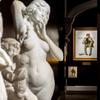Julius LeBlanc Stewart: An American in the Paris Salon
- July 22, 2020 13:49
Nicknamed "the Parisian from Philadelphia," Julius LeBlanc Stewart was an American painter shaped by the competitive French contemporary art landscape of the late 19th century, and he spent his entire career abroad among the American expatriate society. He created a style of his own that was lauded in both Europe and America as utterly original and became a true painter of the Parisian Belle Époque.
Stewart was born in Philadelphia in 1855 into a wealthy and well-connected family. His family moved to Paris when he was only ten, where they were among a large circle of American expats with strong ties to the art world. His father, William Stewart, who had inherited his fortune from his family's Cuban sugar plantation, was a prominent art collector whose interest in collecting only grew in Paris. He became one of the most important patrons of contemporary art in Paris, and his collection consisted of over 200 paintings from the most renowned Academic artists, including Jean-Léon Gérôme, Sir Lawrence Alma-Tadema, Jean-Baptiste-Camille Corot and many others. The Stewart household also hosted weekly salons for close to 25 years, inviting some of the most celebrated Parisian artistic personalities of the day to engage in discussions of art and culture. The young Julius grew up surrounded by art and ideas, and his father encouraged his artistic aspirations.
Stewart studied under Spanish painter and family friend Eduardo Zamacois as a teenager, and at age 18, he joined the atelier of the great Jean-Léon Gérôme. Like his contemporary and fellow expat John Singer Sargent, Stewart found success as a portraitist for the wealthy and fashionable in Parisian Belle Époque society, and he received critical and popular acclaim for these depictions at the Paris Salon. He first exhibited at the Salon in 1878 and continued to do so until 1910, excelling in the large canvases that did so well there and winning numerous awards of merit. Despite hailing from America, one critic called him a "true historian" of contemporary French society, and his early successes at the Salon cemented this reputation.
Salon juries were the appointed arbiters of good taste at the time and acceptance into the exhibition was essential to artistic self-promotion. No other exhibit ensured the same levels of recognition from critics and exposure to new patrons. Even into the last half of the 19th century, as modernism began to take hold of the art world, the Salon continued to be a vital aspect of an artist's financial success. A memorable showing at the Salon could signal the start of a promising career and even elevate the artist to celebrity status — a fact that enticed many American artists.
Yet, it was difficult for American artists to earn coveted wall space at the exhibition. A work by an American was only first accepted at the Salon in 1800 — over a century after the Académie Royale first began hosting exhibitions in 1667. The Salon's reputation and scope grew in the 19th century, yet fewer than 5,000 American works hung in the Salons during that period, compared to the hundreds of thousands of European works. By the mid-1880s, however, Americans did represent the largest foreign faction in the Parisian art community and accounted for 20-25% of all foreign exhibitors at the Salons of the 1890s. Nevertheless, the Salon remained highly competitive, and it was relatively rare for Americans to be accepted into the prestigious exhibition.
Stewart was an advocate for his community of fellow American artists in France. He was a core member of the Paris Society of American Painters (PSAP), an artist collective comprised of expats who had received academic training at the École des Beaux-Arts. Members exhibited together and largely favored a conservative style, displaying their mastery of the French Academic style. Stewart served as co-chairman for the "Americans in Paris" section of the 1894 Salon and helped organize the American section at the 1894 Antwerp International Exhibition. He was also named Chevalier of the Legion of Honor in 1895 and Officer in 1901 for his services and achievements in the French art community.
The 1890s saw Stewart's style evolve and international reputation grow, leading him to the height of his fame. Eventually, he transitioned to painting depictions of multi-figured, narrative scenes and sensuous nudes bathed in sunlight. By this time, nude female figures or "Venuses" were essentially the raison d 'être for the Salon, with artists looking to showcase their refined treatment of the human body, usually veiled in history or mythology. Stewart's female figures are young and spirited, and he delighted in the sensuality associated with the traditional French academic female figure. Stewart exhibited a total of seven paintings at the 1899 Salon, but only one — Nymphes Chasseresses — was singled out for review. Remarkable in quality and stunning in beauty, Nymphes Chasseresses demonstrates Stewart's dedication to academic figure painting.
Click here to learn more about Julius LeBlanc Stewart and this important Salon painting.
About M.S. Rau:
M.S. Rau has spent more than 100 years earning the trust of discerning collectors worldwide. Located in the heart of New Orleans' historic French Quarter, our peerless showroom houses one of the world's most extensive and stunning collections of museum-quality fine art by artists such as Claude Monet and William Bouguereau, 18th- and 19th-century antiques and breathtaking jewelry, including rare colored diamonds.






100x100_c.jpg)













